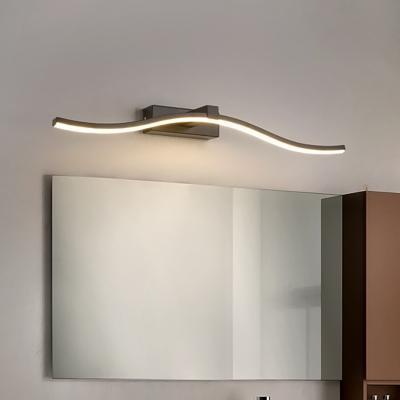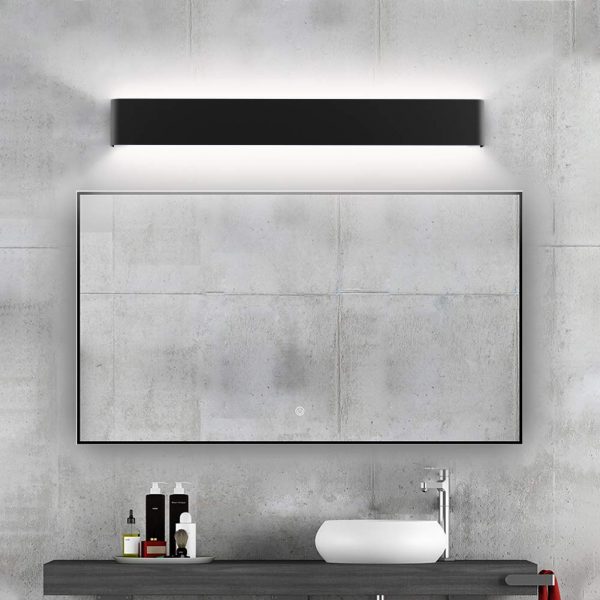Modern bathroom lights over mirrors have become a crucial aspect of bathroom design, combining functionality with aesthetic appeal. The proper lighting not only illuminates the space for practical uses such as shaving or applying makeup but also enhances the overall ambiance of the bathroom. These lights are available in various styles, from sleek, minimalist designs to more elaborate, decorative fixtures, catering to different tastes and design preferences.
One of the primary considerations when selecting modern bathroom lights over the mirror is the type of light source. LED lights have gained immense popularity due to their energy efficiency, long lifespan, and versatility. They offer a range of color temperatures, from warm to cool, allowing homeowners to customize the lighting according to their needs. LED lights also provide consistent illumination without the flickering often seen in traditional bulbs, ensuring a pleasant and comfortable experience.

The placement of the lights is another critical factor. Ideally, the lights should be positioned at eye level or slightly above to minimize shadows on the face. This can be achieved through wall-mounted sconces on either side of the mirror or a light bar mounted above it. For larger mirrors, a combination of both side and top lighting can ensure even illumination. The goal is to provide balanced lighting that eliminates harsh shadows, making daily grooming tasks more manageable.
When it comes to style, modern bathroom lights over mirrors come in an array of designs to complement any bathroom decor. Minimalist fixtures with clean lines and metallic finishes are perfect for contemporary spaces, while more ornate designs can add a touch of elegance to traditional bathrooms. The choice of finish, whether chrome, brushed nickel, or matte black, can further enhance the overall look, creating a cohesive design that ties the bathroom together.

Dimmable lights are an excellent feature of modern bathroom lighting. They allow users to adjust the brightness according to the time of day and personal preference. In the morning, brighter lights can help wake you up and provide the necessary illumination for tasks like shaving or applying makeup. In the evening, dimmer lights can create a relaxing atmosphere, perfect for winding down before bed.
Another innovative feature in modern bathroom lighting is the incorporation of smart technology. Smart lights can be controlled via smartphone apps or voice assistants, offering convenience and flexibility. Users can program the lights to turn on and off at specific times, adjust the brightness remotely, and even change the color temperature to suit their mood. This level of control enhances the functionality of bathroom lighting, making it a more integral part of the home’s smart ecosystem.

Safety is a crucial consideration in bathroom lighting, given the presence of water and humidity. Fixtures should be rated for damp or wet locations to ensure they can withstand the bathroom environment. It’s also essential to install lights with proper sealing and insulation to prevent moisture from entering the electrical components, reducing the risk of electrical hazards.
Energy efficiency is another important aspect of modern bathroom lights over mirrors. LED lights, in particular, consume significantly less energy than traditional incandescent bulbs, helping to reduce electricity bills and environmental impact. Many LED fixtures are also compatible with energy-saving dimmers, allowing further energy conservation. Opting for energy-efficient lighting is not only beneficial for the environment but also cost-effective in the long run.
Task lighting is a critical component of bathroom lighting design. This type of lighting focuses on providing adequate illumination for specific tasks, such as shaving, applying makeup, or brushing teeth. Proper task lighting can reduce eye strain and improve the accuracy of these activities. For example, a lighted mirror with built-in LED lights can offer uniform illumination, ensuring that every detail is visible.
Ambient lighting, on the other hand, provides general illumination for the entire bathroom. This type of lighting sets the overall mood and can be achieved through ceiling fixtures, recessed lights, or a combination of both. The goal is to create a well-lit space that feels inviting and comfortable. Ambient lighting should be complemented by task lighting to ensure that all areas of the bathroom are adequately lit.
Accent lighting is used to highlight specific features or add a decorative touch to the bathroom. This can include spotlights aimed at artwork, decorative fixtures that serve as focal points, or backlit mirrors that add a soft glow to the space. Accent lighting can enhance the visual appeal of the bathroom, making it feel more luxurious and personalized.
Natural light should also be considered when planning bathroom lighting. Windows, skylights, or solar tubes can bring in natural daylight, reducing the need for artificial lighting during the day. Natural light can create a bright and airy atmosphere, making the bathroom feel more spacious and welcoming. When combined with artificial lighting, it can ensure that the bathroom remains well-lit at all times.
The choice of light color temperature plays a significant role in the bathroom’s ambiance. Warm white lights (2700K-3000K) create a cozy and inviting atmosphere, suitable for relaxing baths and evening routines. Cool white lights (3500K-4100K) offer a more neutral and balanced illumination, ideal for general tasks and daily activities. Daylight white lights (5000K-6500K) provide a bright and invigorating light, perfect for tasks that require precision, such as applying makeup or shaving.
The installation of bathroom lights over mirrors should be done carefully to ensure both functionality and aesthetics. It’s essential to hire a professional electrician to handle the wiring and installation, ensuring that all fixtures are securely mounted and properly connected. This not only guarantees safety but also ensures that the lights function optimally.
Regular maintenance of bathroom lights is necessary to keep them in good working condition. This includes cleaning the fixtures to remove dust and grime, checking for any loose connections, and replacing any faulty bulbs. Proper maintenance can extend the lifespan of the lights and ensure that they continue to provide adequate illumination.
Common Mistakes to Avoid
One common mistake in bathroom lighting is inadequate lighting. Relying solely on a single overhead fixture can leave parts of the bathroom in shadow, making it difficult to perform tasks like shaving or applying makeup. It’s important to layer different types of lighting – task, ambient, and accent – to create a well-lit space.
Another mistake is ignoring the importance of the color temperature. Using lights that are too warm or too cool can affect the ambiance and functionality of the bathroom. It’s crucial to choose the right color temperature that suits the activities performed in the bathroom and complements the overall design.
Improper placement of lights is also a frequent issue. Placing lights too high or too low can create unflattering shadows and uneven illumination. Lights should be positioned at eye level or slightly above to ensure even lighting across the face.
Failing to consider the style and finish of the light fixtures can lead to a mismatched look that disrupts the bathroom’s aesthetic. It’s essential to choose fixtures that complement the overall design theme and other hardware in the bathroom.
Neglecting the importance of dimmable lights is another oversight. Dimmable lights offer flexibility in adjusting the brightness to suit different times of the day and activities. Installing non-dimmable lights can limit the functionality and ambiance of the bathroom.
And last, overlooking the importance of energy efficiency can result in higher electricity bills and a greater environmental impact. Choosing energy-efficient LED lights can save money in the long run and reduce the carbon footprint of the household.
Why is proper lighting important in a bathroom?
Proper lighting in a bathroom is crucial for both functionality and aesthetics. It ensures that tasks such as shaving, applying makeup, and grooming can be performed accurately and comfortably. Good lighting also enhances the overall ambiance, making the bathroom feel inviting and pleasant. By reducing shadows and providing even illumination, proper lighting improves visibility and safety, particularly in a space prone to moisture and slippery surfaces.
What are the benefits of using LED lights in the bathroom?
LED lights offer numerous benefits for bathroom lighting. They are highly energy-efficient, consuming less electricity than traditional incandescent bulbs, which helps reduce energy bills. LEDs also have a long lifespan, reducing the frequency of bulb replacements. They provide consistent and flicker-free illumination, available in a range of color temperatures to suit different needs. Additionally, LEDs generate less heat, making them safer to use in enclosed spaces like bathrooms. Their versatility in design and compatibility with smart technology further enhances their appeal.
How should bathroom lights be positioned around the mirror?
Bathroom lights should be positioned to minimize shadows and provide even illumination across the face. The ideal placement is at eye level or slightly above, either with wall-mounted sconces on both sides of the mirror or a light bar above it. For larger mirrors, a combination of side and top lighting ensures comprehensive coverage. Proper placement helps eliminate harsh shadows, making grooming tasks easier and more accurate.
What are the different types of bathroom lighting?
Bathroom lighting can be categorized into three main types: task lighting, ambient lighting, and accent lighting. Task lighting focuses on providing bright, direct illumination for specific tasks like shaving or applying makeup. Ambient lighting provides overall illumination for the entire bathroom, creating a comfortable and inviting atmosphere. Accent lighting highlights specific features or adds decorative touches, enhancing the visual appeal of the space. Combining these types of lighting creates a well-lit and balanced environment.
Why is it important to choose damp or wet-rated fixtures for bathroom lighting?
Bathrooms are exposed to high levels of moisture and humidity, which can affect the durability and safety of lighting fixtures. Damp or wet-rated fixtures are specifically designed to withstand these conditions, preventing moisture from entering the electrical components. Using fixtures not rated for wet locations can lead to electrical hazards, such as short circuits or fires. Ensuring that bathroom lights are appropriately rated enhances safety and longevity.
How can I make my bathroom lighting more energy-efficient?
To make bathroom lighting more energy-efficient, consider using LED bulbs, which consume less electricity and have a longer lifespan compared to traditional bulbs. Installing dimmable lights allows you to adjust the brightness according to your needs, further conserving energy. Opt for fixtures with an Energy Star rating, which meet stringent energy efficiency guidelines. Additionally, incorporating natural light through windows or skylights can reduce the reliance on artificial lighting during the day.
Dos and Donts of Indoor Lighting Design Modern bathroom
BDL Bathroom Vanity Light Fixtures
On-Trend Bathroom Lighting Ideas
How To Pick A Modern Bathroom Mirror With Lights
Related articles:








